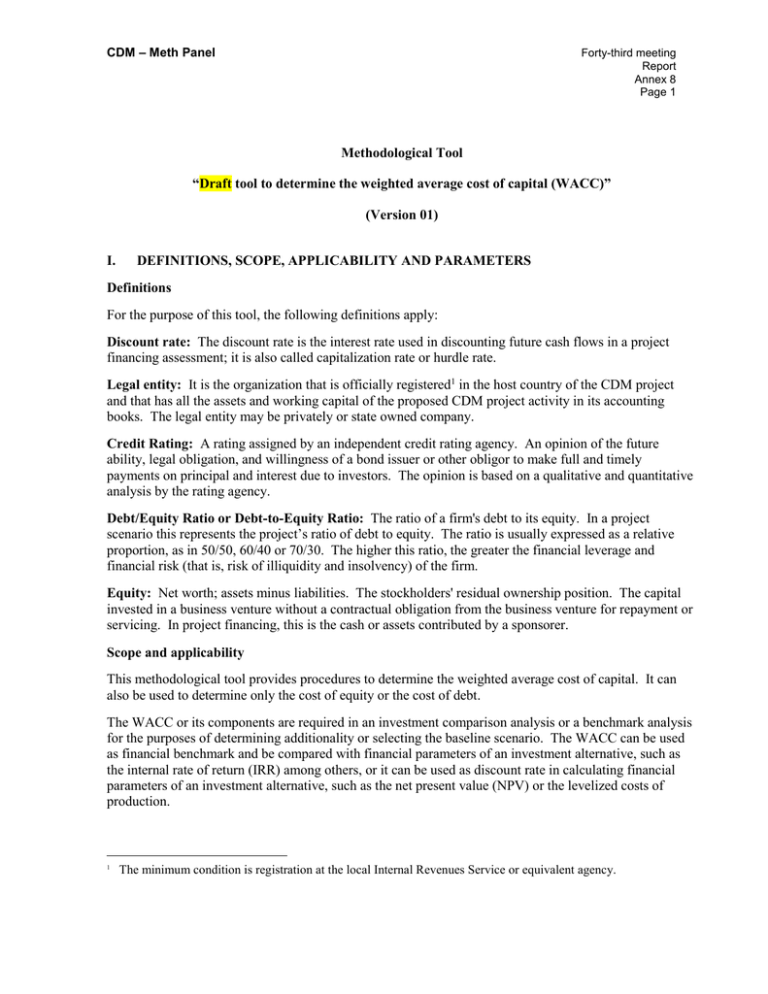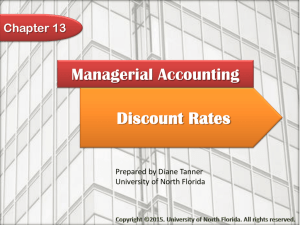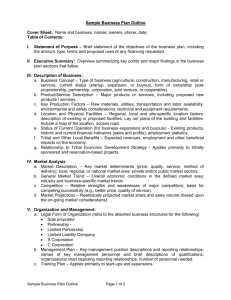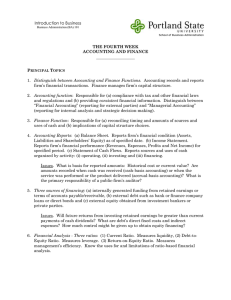Methodological Tool (Version 01)
advertisement

CDM – Meth Panel Forty-third meeting Report Annex 8 Page 1 Methodological Tool “Draft tool to determine the weighted average cost of capital (WACC)” (Version 01) I. DEFINITIONS, SCOPE, APPLICABILITY AND PARAMETERS Definitions For the purpose of this tool, the following definitions apply: Discount rate: The discount rate is the interest rate used in discounting future cash flows in a project financing assessment; it is also called capitalization rate or hurdle rate. Legal entity: It is the organization that is officially registered1 in the host country of the CDM project and that has all the assets and working capital of the proposed CDM project activity in its accounting books. The legal entity may be privately or state owned company. Credit Rating: A rating assigned by an independent credit rating agency. An opinion of the future ability, legal obligation, and willingness of a bond issuer or other obligor to make full and timely payments on principal and interest due to investors. The opinion is based on a qualitative and quantitative analysis by the rating agency. Debt/Equity Ratio or Debt-to-Equity Ratio: The ratio of a firm's debt to its equity. In a project scenario this represents the project’s ratio of debt to equity. The ratio is usually expressed as a relative proportion, as in 50/50, 60/40 or 70/30. The higher this ratio, the greater the financial leverage and financial risk (that is, risk of illiquidity and insolvency) of the firm. Equity: Net worth; assets minus liabilities. The stockholders' residual ownership position. The capital invested in a business venture without a contractual obligation from the business venture for repayment or servicing. In project financing, this is the cash or assets contributed by a sponsorer. Scope and applicability This methodological tool provides procedures to determine the weighted average cost of capital. It can also be used to determine only the cost of equity or the cost of debt. The WACC or its components are required in an investment comparison analysis or a benchmark analysis for the purposes of determining additionality or selecting the baseline scenario. The WACC can be used as financial benchmark and be compared with financial parameters of an investment alternative, such as the internal rate of return (IRR) among others, or it can be used as discount rate in calculating financial parameters of an investment alternative, such as the net present value (NPV) or the levelized costs of production. 1 The minimum condition is registration at the local Internal Revenues Service or equivalent agency. CDM – Meth Panel Forty-third meeting Report Annex 8 Page 2 Any investment analysis must be done in the same currency selected for the WACC calculation. All cash flows for income, expenses, costs, etc must be standardized using a single currency or reasonable equivalent in the timeframe of the assessment. This tool is not applicable in case of project activities proposed in Least Developed Countries as per guideline regarding Least Developed Countries” of the Executive board under Annex 13 of EB 50 report for “GUIDELINES FOR OBJECTIVE DEMONSTRATION AND ASSESSMENT OF BARRIERS”. Parameters This tool provides procedures to determine the following parameters: Parameter r kd ke SI Unit - Description WACC Average cost of debt financing Average cost of equity financing Note: No methodology-specific parameters are required. II. METHODOLOGY PROCEDURE The weighted average cost of capital (WACC, r) is calculated as follows: r = wdKd(1-T) + weKe Where: r wd we kd ke T = = = = = = (1) WACC Percentage of debt financing Percentage of equity financing Average cost of debt financing Average cost of equity financing Applicable corporate tax rate The parameter r calculated as above is to be considered as an after-tax benchmark/discount rate i.e. the economic/financial analysis using this parameter shall include the corporate tax expense. The WACC or its components should be calculated in the same terms (real or nominal) as in the investment comparison analysis or benchmark analysis. Apply the following steps to determine the kd, ke, wd, , we and T. Step 1: Determine whether r is estimated based on the situation of the entity undertaking the project activity or based on standard market expectations for the project type Document and justify in the CDM-PDD which of the following two situations applies to the project activity: (I) The project activity can only be implemented by the project participants and not by an entity other than project participant, or CDM – Meth Panel Forty-third meeting Report Annex 8 Page 3 (II) The project activity could also be implemented by entities other than the project participants. Where case (I) applies, the financial discount rate or financial benchmark shall be determined based on the specific financial/economic situation of the entity undertaking the project activity. Where case (II) applies, the financial discount rate or financial benchmark shall be determined based on parameters that are standard in the market, considering the specific characteristics of the project type, but not linked to the subjective profitability expectation or risk profile of a particular project developer. Step 2: Determine the status of the legal entity that will host the project activity assets Where case (II) in Step 1 applies, document and justify in the CDM-PDD which of the following two situations applies to the project activity: (a) The accounting books of the legal entity reflect at least the total value of all the assets needed for the project activity; or (b) The accounting books of the legal entity do not reflect the total value of all the assets needed for the project activity. If case (a) applies, we and wd will be determined based on the accounting books of the legal entity. If case (b) applies, the default debt-equity ratio should be applied. Step 3: Determine the average cost of debt financing (kd) Use one of the following options to determine kd: Option 3A: Use the weighted average cost of debt financing of the legal entity This option can be used if: Case (I) in Step 1 applies; Case (a) in Step 2 applies; and The legal entity owning the project assets uses some form of debt financing with a maturity of more than one year. 2 Under this option the project participants should document the following: 2 For bonds: the key parameters of the bond including time to maturity, yield, registration issuance in the financial system and set-up in the market. For loans from a financial institution: the contract of lending between the financial institution and the legal entity owning the assets of the project activity. In absence of the contract, provide a letter from the bank stating its intention to award the loan and the key terms for the loan. Debt with a maturity below one year is typically current debt with different interest rates than the interest rates of long term debt and should not be considered in the analysis. CDM – Meth Panel Forty-third meeting Report Annex 8 Page 4 If the legal entity uses debt financing from a parent company (corporate treasury or headquarter), the transfer of capital to the legal entity must be documented with: o The parameters of the corporate bonds as mentioned above. This option is only valid for corporate bonds issued in the host country of the CDM project; o The contract of lending between the parent company and the legal entity owning the assets of the project activity. The parameter kd should be calculated as the weighted average cost of debt funding of the legal entity owning the project activity. For bonds, use the weighted average yield of the bonds during the last three months prior to the submission of the CDM-PDD for validation or prior to the investment decision, whichever is earlier. For loans, use the weighted average cost of outstanding long-term debt. Option 3B: Use the cost of debt of the financial system This option can be used if: Case (II) in Step 1 applies; or Case (I) in Step 1 and case (b) in Step 2 apply and the debt finance structure for the project is not yet available (e.g. a letter of intent for debt funding is not yet available). The parameter kd should be calculated as the cost of financing in the capital markets (e.g. commercial lending rates and guarantees required for the country and the type of project activity concerned), based on documented evidence from financial institutions with regard to the cost of debt financing of comparable projects. In the case this data is not available, use the commercial lending rate in the host country for the calculation of kd. Option 3C: Use the cost of government bond rates as cost of debt This option can be used if: Case (II) in Step 1 applies; or Case (I) in Step 1 and case (b) in Step 2 apply and the debt finance structure for the project is not yet available (e.g. a letter of intent for debt funding is not yet available); and The government of the host country has issued at least one bond. The parameter kd can be assumed as the yield of a 10 years bond issued by the government of the host country or, if this is not available, the bond with the maturity which is closest to 10 years. Step 4: Determine the average cost of equity financing (ke) Option 4A: Use the average global expected equity return This option can be used if: Case (I) or (II) in Step 1 applies. CDM – Meth Panel Forty-third meeting Report Annex 8 Page 5 This approach represents an estimated equity return based on a average historical global equity risk premium. The parameter ke is calculated equivalent to a risk free rate (calculated as the yield of a government bond issued by the host country minus the country default spread) plus a global equity risk premium, as follows: Ke = [GBi –CDS] + PEg Where: ke GBi CDS PEg = = = = (2) Average cost of equity financing Yield of a government bond issued by the host country Country Default Spread Global equity risk premium The parameter Ke should be determined as follows: GBi should be determined as the yield of a ten year government bond issued by the host country, as observed on average in the past 3 years prior to the preparation of the CDM-PDD . If such a bond is not available, the bond with maturity which is closest to 10 years should be used. This bond will have the following options: o GB1, a bond issued in USD terms; o GB2, a bond issued in local currency of the CDM project host country; CDS is calculated from a reliable source of Country Default Spread Database, using the rating of the country hosting the CDM project. An international source with at least 5 years in the market and a clear methodology for emerging/developing economies credit rating will be used (e.g. A.M. Best, Standard & Poor's, Moody's or Fitch Ratings, among others); Assume a default value of 4.7% for the parameter PEg.3 Note: The project risk is not included in this equation because project participants can reflect the project specific risks in the cash flow analysis in the investment comparison or benchmark analysis as laid out in the sub-step 2C, paragraph 8 of “Tool for the demonstration and assessment of additionality”. This tool may include some guidance on project risk measurement in future versions. Option 4B: Use the country specific equity return This option can be used if: 3 Case (I) or (II) in Step 1 applies. “The worldwide equity premium: A smaller puzzle” by Elroy Dimson, Paul Marsh and Mike Stauntun from London Business School. CDM – Meth Panel Forty-third meeting Report Annex 8 Page 6 This approach provides an equity return which differentiates according to the country risk. This means that for a country with a high country risk (as reflected in its government bond) a higher equity return (ke) will be calculated compared to a country with a low country risk. The parameter ke is calculated equivalent to a risk free rate plus a country risk premium plus a general equity risk premium, as follows: Ke = GB + PEg (3) OR Ke = RF + CDS + PEg Where: ke RF GBi CDS PEg = = = = = (4) Average cost of equity financing Risk free rate Yield of a government bond issued by the host country Country Default Spread General equity risk premium Equation 3 should be used if the government of the host country has issued a bond with a maturity of at least one year. Otherwise, equation 4 should be used. The parameter Ke should be determined as follows: GBi should be determined as the yield of a ten year government bond issued by the host country in its local currency, as observed on average in the past 3 years prior to the preparation of the CDM-PDD. If such a bond is not available, the bond with maturity which is closest to 10 years should be used; CDS is calculated from a reliable source of Country Default Spread Database, using the rating of the country hosting the CDM project. An international source with at least 5 years in the market and a clear methodology for emerging/developing economies credit rating will be used (e.g. A.M. Best, Standard & Poor's, Moody's or Fitch Ratings, among others); RF is determined as the yield of a ten year USD bond, as observed on average in the past 3 years prior to the preparation of the CDM-PDD; For PEg a default value of 4.1% is used.4 Note: The project risk is not included in this equation because project participants can reflect the project specific risks in the cash flow analysis in the investment comparison or benchmark analysis as laid out in the Sub-step 2C, paragraph 8 of “Tool for the demonstration and assessment of additionality”. This tool may include some guidance on project risk measurement in future versions. Option 4C: Use the specific equity expectations of the legal entity 4 “The worldwide equity premium: A smaller puzzle” by Elroy Dimson, Paul Marsh and Mike Stauntun from London Business School. CDM – Meth Panel Forty-third meeting Report Annex 8 Page 7 This option can be used if: Case (I) in step 1 applies; The legal entity can document that one specific expected equity return has been consistently used in the past, i.e. that project activities under similar conditions developed by the same company used the same value for ke. The parameter ke should correspond to the value consistently observed in the past for ke. Provide transparent documentation in the CDM-PDD on the consistent use of this value in the past5. Step 5: Determine the percentage of debt financing (wd), and equity financing (we) Option 5A: Use the latest balance sheet under local fiscal/accounting standards and rules This option can be used if: Case (I) in Step 1 applies; Case (a) in Step 2 applies; and The legal entity owning the assets of the project activity has balance sheets audited by a third party within two years prior to the submission of the CDM-PDD for validation. The values of the long term debt and equity should be taken as documented in the accounting books of the legal entity. The parameters wd and we should be determined as follows: wd should be calculated by dividing the total value of the debt with a maturity above one year by the sum of (a) the total value of the equity and (b) the total value of the debt with a maturity above one year; we should be calculated by dividing the total value of the equity by the sum of (a) the total value of the equity and (b) the total value of the debt with a maturity above one year. Option 5B: Default value This option can be used if: Case (II) in Step 1 applies; or Case (I) in Step 1 and case (b) in Step 2 apply and the debt finance structure for the project is not yet available (e.g. a letter of intent for debt funding is not yet available). Use a default value of 0.5 for wd and 0.5 for we. Step 6: Determine the applicable tax rate (T) 5 The equity may include common stocks and preferred stock. CDM – Meth Panel Forty-third meeting Report Annex 8 Page 8 The applicable tax rate will be the official value of the corporate tax rate as issued by the internal revenues service agency or similar institution in the host country of the CDM project. If the Government has differentiated values according to the revenues levels of legal entity; document and justify this scale. III. MONITORING METHODOLOGY No monitoring provisions apply. ----History of the document Version 01 Date EB 53, Annex # 26 March 2010 Decision Class: Regulatory Document Type: Tool Business Function: Methodology Nature of revision(s) To be considered at EB 53.






